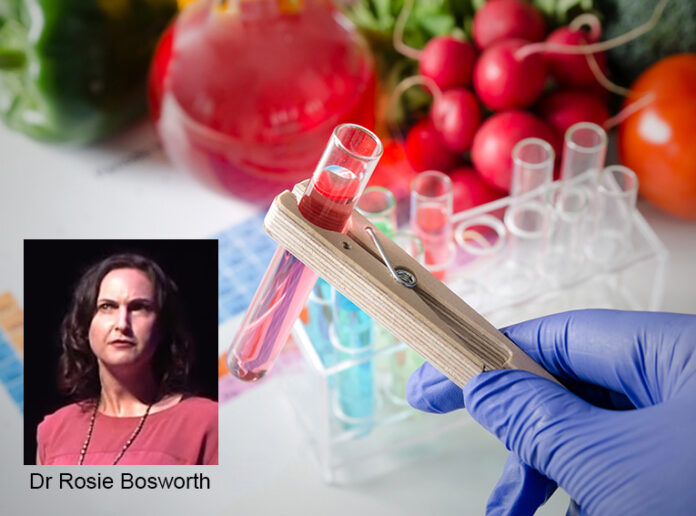There’s a revolution coming in food although some would say, it’s already well underway. Dr Rosie Bosworth of the University of Auckland is one of them. Bosworth wears several hats but her most notable fascinator carries the label, ‘disruptive technologist’.
The term disruptive technology has been around for a few years. Still, it has become more commonly used since energy experts like Tony Seba began to explain how it affects us in areas like transportation, cell phone technology and in the rapid development of LIDAR which makes autonomous vehicles possible.
As Seba explains it, disruptive technologies are sneaky things.
He cites an example of what happened to AT&T when, in 1985, it asked McKinsey & Co to forecast cell phone adoption rates by the year 2000. Their 15-year prediction was 900,000 subscribers. The actual number turned out to be 109 million.
AT&T took heed of the advice it had paid $5 million for, and subsequently, its landline business went down, It missed out on hundreds of millions of market capitalisation.
And that’s the problem with mainstream analysts, according to Seba. They, like the giants of industry already involved, fail to see what’s coming at them.
Seba says it’s usually the experts and the inside analysts that dismiss a disruptive opportunity. He poses the now laughable question, “why, 10 years ago, would anyone buy a $600 iPhone when they could buy the $100 Nokia? It makes no sense, right?”
It also happened in photography.
The first digital camera was invented by Steven Sasson, an engineer at Eastman Kodak in 1975. Fast forward to the year 2000 when picture taking was at its absolute height and Kodak was making massive profits.
Twelve years later, it filed for bankruptcy.
That’s what disruptive technology does. In Kodak’s case management failed to realise the value of what they had and went out of business when digital photography became the norm.
Rosie Boswell believes New Zealand’s traditional agriculture producers are facing a similar fate. She envisages a new world for agriculture and has branded it Agriculture 2.0. And, she says, it’s a disruptive technology that’s already right on our doorstep.
Agriculture 2.0 will be enabled by biology, science and technology.
She says the revolution has already begun and is being led by food technologists, biologists, medical doctors, engineers and foodies.
“All are being driven by a common goal – to turn the existing food paradigm on its head and create a better world for all involved.”
She sees a new food revolution brewing where animals and rolling pastures may have little to do with the future of our milk, meat, chicken and even seafood.
“These images may seem like something out of the Jetsons or Star Wars, but they are very real, and they are already starting to change the world of global food and agriculture in a positively profound way.
“Companies like Beyond Meats and Impossible Foods in the United States have designed burgers that look, cook, taste and drip fat and even bleed as your traditional beef burger would.
“The only catch – not a cow in sight. They’re made entirely from plants. No hormones or antibiotics, and they’re produced at a fraction of the environmental harm.”
Boswell is hard on the negative effects of traditional agriculture and cites facts like it takes 15,000 litres of water to produce 1 kilo of beef, accounts for 70 per cent of water use and is the major polluter of our waterways.
While there is a gathering consensus that farming needs to become more environmentally friendly, Boswell might still be an academic voice in the wilderness if wasn’t for the fact that she now has a powerful ally.
In early October, Britain’s Guardian newspaper reported on the need for a major review of the world’s food systems. In a report on a study just completed it said, “huge reductions in meat-eating are essential to avoid dangerous climate change.”
The new study follows the publication of a landmark UN report in which the world’s leading scientists warned there are just a dozen years in which to keep global warming under 1.5C, beyond which even half a degree will significantly worsen the risks of drought, floods and extreme heat.
The report said eating less meat and dairy was important but said current trends were in the opposite direction.
The researchers found a global shift to a “flexitarian” diet was needed to keep climate change even under 2C, let alone 1.5C. This flexitarian diet means the average world citizen needs to eat 75% less beef, 90% less pork and half the number of eggs, while tripling consumption of beans and pulses and quadrupling nuts and seeds.
This would halve emissions from livestock, and better management of manure would enable further cuts.
In rich nations, the dietary changes required are ever more stark. UK and US citizens need to cut beef by 90% and milk by 60% while increasing beans and pulses between four and six times.






